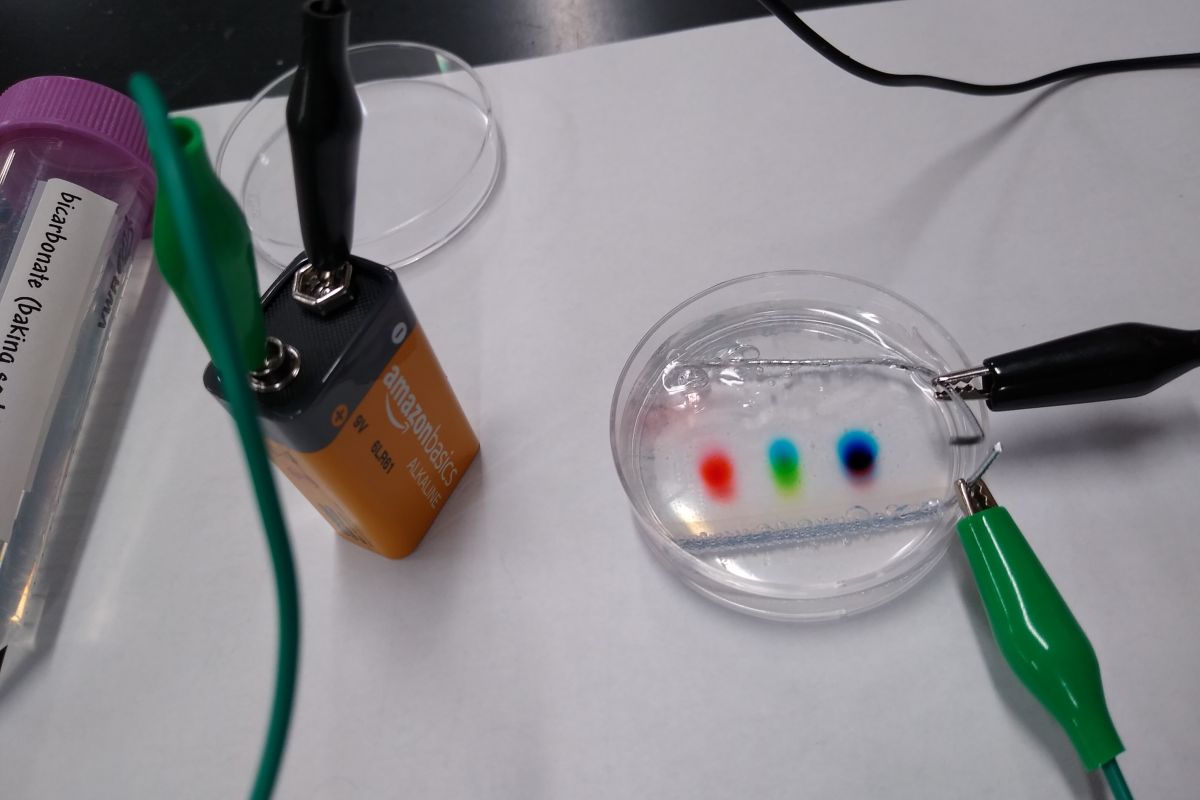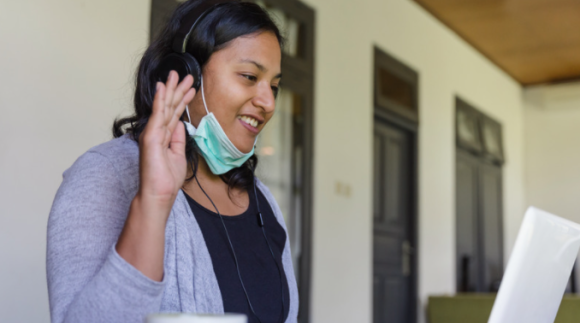As a new school year begins for students in many areas of the world, teachers have been reflecting on a year of adaptation and resilience in the face of the COVID-19 pandemic. Uncertainties for the upcoming year remain, as the risk from the disease continues to loom with the Delta and other variants of the virus. However, teachers now have a year’s worth of lessons in both best practices for virtual tools as well as ways to best support their students to guide them moving forward.
We spoke with several Amgen Biotech Experience (ABE) teachers, and the following five lessons emerged.
1. Embrace Existing Digital Tools
When Westborough High School in Massachusetts switched to remote learning in March of 2020, Todd Ryan was one of many ABE teachers who were thrust into remote education on Google Meets or Zoom. He said that his initial classes were “sage on a stage” in a way that was antithetical to the way he taught students in person.
“In person, I could do activities, modeling, and laboratories, but the students didn’t have materials at home to do this and I had no simple, equitable way to deliver materials to students and then pass them on safely to other classes for the same activity,” he reflected. But “‘sage on a stage’ got old for the students quickly.”
While some teachers switched quickly to using breakout rooms and small-group discussions, Ryan was not an early adopter. It took him a while to converse with other educators and develop strategies for interactions with existing digital tools. He started with polls in Zoom rooms. Prior to sharing the poll, he would ask a few individual students to comment on each of the options provided and whether they liked or disliked that option. “This simple question and answer where everyone had to choose an answer was one of the first and is still one of my primary ways of dividing up lecture time online and getting students more engaged with our topic,” Ryan said.

Aideen Nally, an ABE Ireland teacher, said she changed many aspects of her teaching during the pandemic. “The move to online live Zoom classes has had its challenges, but it has also resulted in skills that both my students and I will take into the future post pandemic,” she said. One of the major lessons for her was the need for peer interactions, and breakout rooms were a great solution. “The students got a chance to work through material together and, at the same time, got to talk to their friends, which they missed,” she said.
Andrew Cussen, another ABE Ireland teacher, also used breakout rooms for the first time ever this past year. “In the classroom, I have always encouraged peer mentoring and teaching methodologies,” Cussen said. “The breakout rooms allowed me to continue this.”
Other features of existing digital tools that came in handy included the voice note functions, such as on Schoology, for delivering quick personalised feedback to students, and recordings of class sessions. “I recorded all my lessons so that students could replay and review them at their own pace,” said Kate Song, an ABE Greater Los Angeles Area (ABE-LA) teacher. “I plan to continue the use of interactive technology platforms to increase student engagement and love for science.”
2. Take on New Virtual Lab Tools
Not having the ability to do hands-on laboratories has been a significant challenge for ABE teachers during the pandemic. Said Song of ABE-LA: “One of the toughest aspects of online learning was the completion of labs in a meaningful way.” She used demonstrations and online virtual labs, including work on graphing and spreadsheets.
“In spite of the challenges faced with the virtual learning environment, I was determined to continue to share this biotech experience with the students,” said Sheila Guard, an ABE Washington State teacher. She conducted a demonstration online and enabled her students to perform a virtual transformation. “They used computer modeling programs to see what was happening as I cut the plasmid and inserted the genes, and ran the confirming gel electrophoresis,” Guard explained. Although it was challenging to share via a camera, she said that students generated good diagrams and asked questions that demonstrated their understanding.
One new tool that was available was LabXchange, which launched just a couple months before the pandemic began. Designed to give students new ways to virtually learn about the biosciences, LabXchange includes articles, videos, and interactive lab simulations, as well as lots of ways to interact with other students, scientists, and educators in the life science community. The ABE landing page on LabXchange provides direct links to the ABE cluster, related pathways and assets. The ABE Program Office and LabXchange offers scheduled and on-demand webinars and workshops to assist teachers in using and navigating LabXchange.
Sydney Johnson, an ABE San Francisco Bay Area (ABE-SF) teacher, said she did several modules in LabXchange to replace many of the experiments they would typically do. It’s “a tool I will use in the future to supplement lab work, especially around the ABE [Foundations of Biotech] series,” she said.
David Upegui, an ABE Rhode Island (ABE-RI) teacher at Central Falls High School, used LabXchange to teach students about COVID-19, including about the virus, vaccinations, symptoms, and biotechnology being used to help. “After these sessions and activities, my students knew more about COVID-19 than the average person,” he wrote in a recent article for ABE. “They had become student-experts.”

Katherine Sutton of ABE-RI also learned how to incorporate LabXchange into her teaching toolkit, saying she found it “extremely valuable” in her daily lessons.
3. Go Beyond Digital
While digital tools were invaluable to ABE teachers, Julie Pugh of ABE-LA said it was not the virtual environments that gained the interest of her students “but a chance to explore away from the computer screen that became the best venue for learning.”
Pugh was fortunate to have a budget to create a safe take-home lab kit for her biology and biotech students. Each kit had everything they needed for six experiments. Writing in a recent ABE article, she said:
“One was simple: diffusion across a cell membrane. The kit contained Dixie cups, sugar packets, spoons, carrots, ruler, graph paper, colored pencils. They could not measure the change by mass, and we could not make molar solutions for each student. But they could make solutions that had no sugar, or with 5, 10, 15, or 20 sugar packets, and they could then measure the change in diameter of a carrot. It allowed them to do parts of the scientific method, dependent and independent variables, graphing, analyzing data, collaborating, and drawing conclusions.”
Teachers in ABE-SF also had access to at-home kits through their local Amgen office. And others made their own. With a bit of scavenging for materials, teacher Laura O’Brien was able to provide six lab kits to her students. “My personal favorite was gel electrophoresis in a petri dish with a 9V battery power supply and paper clip electrodes,” she said. “While I'm unsure that students quite comprehended that they were able to perform a version of a procedure that would normally require thousands of dollars of equipment, they definitely were engaged in seeing the separation of the dyes in food coloring.”

In addition to using at-home lab kits, the shift to virtual learning gave teachers more time for often-overlooked areas in their curricula. “The upside to the necessary shifts in my curriculum was significantly more time to dig into bioethics, as well as vaccine and pharmaceutical development,” said Johnson of ABE-SF. Her class also looked at understanding epidemiologist reports and recommendations and also learned about the progress of vaccination clinical trials. (For more on clinical trials, view ABE’s Clinical Trials: From Disease to Medicine classroom module.)
4. Learn and Grow from Each Other
“This has certainly been a difficult year for both students and staff. However, we have adapted to the unique circumstances, and I am confident that we will bring this learning forward to our classrooms in the future,” said Cussen of ABE Ireland. “Collaboration and networking with other teachers has been an essential feature of progressing through this experience.”
Indeed, many ABE teachers reflected on the growth that has occurred both by collaborating with peers and from learning from their students. Kerri Scott of ABE Massachusetts said: “I have learned how important it is for me to have students interact with me and each other. I have also learned that my students are very aware of their own needs and wants when it comes to class sizes and learning styles.”
Listening to students throughout the pandemic has been critical to adaptation. For Pugh of ABE-RI, social–emotional learning has been more than just a buzzword. “Students struggled this year with emotional health and isolation from their friends and teachers,” she wrote in her aforementioned ABE article. It was important for her to set flexible deadlines and to provide any support needed to her students.
“Students who had lost a loved one or who were concerned about grandparents could come in and talk and share through Zoom,” Pugh wrote. “Part of the students’ daily routine and requirement was to have a ‘greeter’ each day that had to ask each person in class a fun or silly question.”
For Sudhe Pande of ABE Washington State, the pandemic has “taught me to be patient,” she said. “I think a lot of us built resilience during this pandemic. Many of us have become kind and have started empathizing with each other.”
5. Build Toward the Future
After a long year of adaptation, teachers continue to face challenges from COVID-19. But ABE teachers are showing the strength of their determination and resilience, continuing to work to build the next generation of scientists and thinkers.
Bonnie Daley of ABE-SF is cautiously optimistic. “I am optimistic that the experiences that students had during this pandemic will make them better adapted for changes in the future because most children are resilient,” she wrote in a recent article on the ABE website. “I am concerned about those children who are less resilient. Will the deficits they suffered in this year and a half handicap them for the rest of their educational years and perhaps for their lives?”
But she said she is also “optimistic about what teachers have learned during this time. They will have a better grasp of digital resources and how to implement them. And I believe our curriculum specialists have done a great job of helping us with lesson plans, slide shows, and professional development that would have looked very different had we still been in the classroom.”
Sutton of ABE-RI is also optimistic. “Amidst a year of chaos and uncertainty, we are finding ways to engage, teach, and learn,” she said “My students have banded together to create a safe haven of hope for their future.”
At the end of the last school year, Sutton wrote: “Reflecting back, I am extremely blessed to be in the position I’m in. I highly value my role within these young people’s lives and can only hope I can continue to inspire them as they inspire me. I sleep better at night knowing progress is being made for a bright future.”
